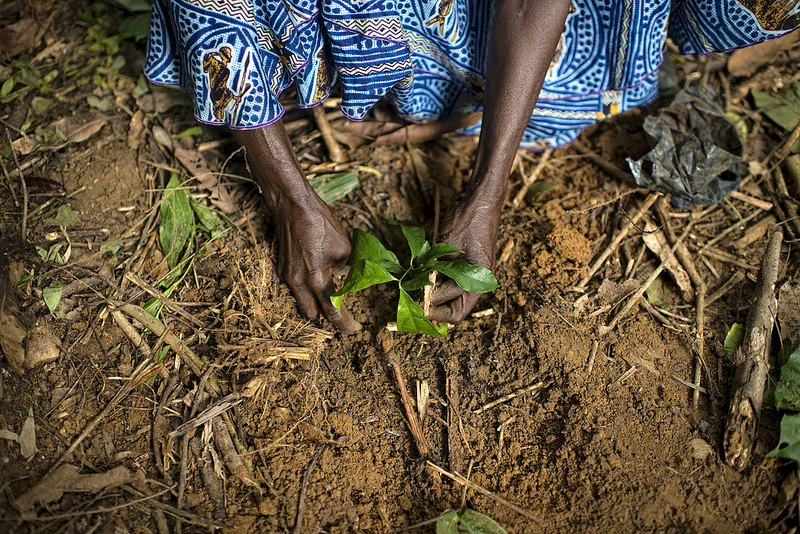BOGOR, Indonesia (26 March, 2013)_A new review of strategies to prepare for the impacts of climate change shows that expanding forests worldwide by planting more trees is unambiguously a good idea. But if not planned carefully, policymakers could waste resources and have unintended consequences, says a new study by the Center for International Forestry Research (CIFOR).
The problem boils down to the simple fact that we don’t really know what will happen in the future as the planet warms: “How can we plan for adaptation when climate modeling itself is so full of uncertainties?” explains Emilia Pramova, CIFOR researcher and lead author of Forests and trees for social adaptation to climate variability and change.
Ecosystem-based adaptation, which seeks to protect ecosystem services – such as air purification by trees, or water retention by soils – is seen as a win-win solution that would help communities buffer the impacts of a warmer world through the cushioning effect of cooling, carbon-dioxide soaking forests.
But the entire field is very new, says Pramova, which is exactly what makes designing strategies so difficult.
“There is a lot of hype about how ecosystem-based adaptation is potentially so effective as well cost-effective, so we decided to see if there was any actual evidence in the science for this,” she says.
“It turns out that there actually just hasn’t been much research that has been done on ecosystem-based adaptation.”
However, what research has been done collectively illustrates very clearly and unambiguously that ecosystem-based climate change adaptation strategies have enormous potential to shield both people and places from the effects of climate change, largely because increased tree cover will result in other benefits for people, regardless of how much global temperatures rise.
Increased tree cover will result in benefits for people, regardless of how much global temperatures rise.
Pramova and her co-authors say these benefits roughly fall into five categories.
One, new forests can provide actual products such as timber and honey, enriching and diversifying livelihoods.
“This shows that it’s important to conserve ecosystem services not just for nature’s sake, but also for people’s sake,” she says.
Researchers in Tanzania, Peru and Honduras for example have found that in times of water stress and crop failure or following a natural disaster, people have been able to use forests for charcoal, firewood, fruit, mushrooms and other resources, as a back-up.
Two, trees planted in agricultural areas can regulate water and soil, boosting food production. Studies in Malawi and Zambia have found that more trees helped soils retain nitrogen and water, and in India other studies have documented increased grain yields.
Three, forested watersheds can reduce water loss from parching soils and also help reduce vulnerability to flooding from intensified storms.
Four, forests such as mangroves protect coastal areas – a necessity regardless of warming temperatures, as typhoons, hurricanes and cyclones will always be a threat.

Forests are important for clean and regular water supplies. Jeff Walker/CIFOR
“Ecosystem-based adaptation is simply a no-regret option,” she explains.
And, five, planting more trees in urban areas could have incredibly important impacts for the lives of people, because cities will be severely hit by rising temperatures.
Replacing soils and trees with concrete and buildings leads to the urban heat island effect, which sees cities heat up drastically more than the surrounding leafy countryside: cities in New Jersey will warm on average 2.7 to 3.3 degrees Celsius more than rural areas. In Manchester, just increasing the amount of green cover by 10 per cent will reduce temperature by 2.2 degrees.
But in all cases, she says, the evidence for the benefits of ecosystem-based adaptation is strong at the local level, but weak from the perspective of the wider landscape.
“We know clearly that there is good evidence at the local level, such as with forest-dwelling communities using forest products, but the evidence gets scarcer and scarcer the broader the level gets,” she says.
“We need to understand things from a broader ecological perspective – if we plant certain tree species upstream in a watershed, for example, how will that influence water supply in the downstream areas under conditions of drought?”
“We need to bring in more ecological knowledge to ensure we don’t make sacrifices, and instead create lots of co-benefits.”
For more information about the issues discussed in this article, please contact Emilia Pramova at e.pramova@cgiar.org
This work is part of the CGIAR Research Program on Forests, Trees and Agroforestry and is supported by the French Global Environment Facility, the African Development Bank and the Economic Community of Central African States.
This issue will be one of the topics of discussion at the two-day conference Sustainable forest management in Central Africa: Yesterday, today and tomorrow Yaounde, Cameroon. 22-23 May, 2013.
For CIFOR’s special feature on Central Africa’s forests, visit forestsnews.cifor.org/yaounde
We want you to share Forests News content, which is licensed under Creative Commons Attribution-NonCommercial-ShareAlike 4.0 International (CC BY-NC-SA 4.0). This means you are free to redistribute our material for non-commercial purposes. All we ask is that you give Forests News appropriate credit and link to the original Forests News content, indicate if changes were made, and distribute your contributions under the same Creative Commons license. You must notify Forests News if you repost, reprint or reuse our materials by contacting forestsnews@cifor-icraf.org.
Further reading
Ecosystem-based adaptation to climate change: What role for policy-makers, society and scientists?
Adaptation research needed to fill gaps on forests’ roles beyond local level
Just add trees: How greening concrete jungles will help us adapt to a warming world
Ecosystem-based adaptation to climate change: What scope for payments for environmental services?
Ecosystem services in the national adaptation programmes of action
